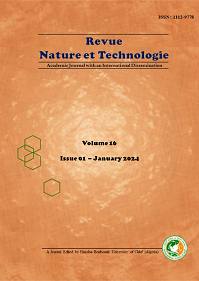L’eau minérale embouteillée en Algérie : quelles perspectives ?
Bottled mineral water in Algeria: What prospects?
Abstract
The production of natural mineral waters bottled in Algeria recognized an exponential growth. The number of brands continues to increase regularly, currently reach one hundred. For this reason, that has fueled our appetite to take an interest in the phenomenon and to know Algerian mineral waters through the labels on the bottles. The objective of this study is to identify and categorize these waters. According to the results found, it appears that the most important of farms are located in the northeastern zone of the country
with a density in the region of Tizi ouzou and Bejaia, belonging to hydrographic basins n°. 3 and no. 4. According to the physicochemical aspects, the waters of Ben Haroun, Mouzaia and Sidi Okba are bicarbonate waters (HCO3 content > 600 mg) and magnesium (Mg content > 50 mg). Ben Haroun water is calcium (calcium content > 150 mg), sodium (> 200 mg.L-1 and sulfated water (> 200 mg From the twenty brands selected waters, fifteen are characterized by a dry residue (DR) that complies with the standard (more than 500 mg Four other have an average DR and are those of Sidi Yakoub (152 mg), El Golea (180 mg), Lala khedidja (187 mg) and El Meniaa (199 mg). The waters of Ben Haroun and Mouzaia are characterized by a high dry residue, which is in order of 2800 and 1280 mg, respectively.

Downloads
Published
How to Cite
Issue
Section
License
Copyright (c) 2024 Revue Nature et Technologie

This work is licensed under a Creative Commons Attribution 4.0 International License.
- All publications of "Nature & Technology Journal" are available under CC-BY Creative Commons Attribution 4.0 International which allows sharing, copying, reproduction, distribution, communication, reuse, adaptation by all means, in all formats and under all licenses.
- Any exploitation of the work or derivative works, including for commercial purposes, is possible. The only obligation is to credit the creators of the authorship of the original works, to indicate the sources and to indicate if modifications were made to the works (obligation of attribution).
This License gives:
- Nature & Technology Journal the right to develop, promote, distribute and archive the article set cited above (including, without limitation, the right to publish the work in whole or in part in any form whatsoever) and ensure the widest dissemination.
- The author (s) reserves the right to use all or part of this article, including tables and figures of his own works, providing that the appropriate recognition is given to the publisher as the holder of the copyrights, and the right to make copies of this article for its own use, but not for sale.




